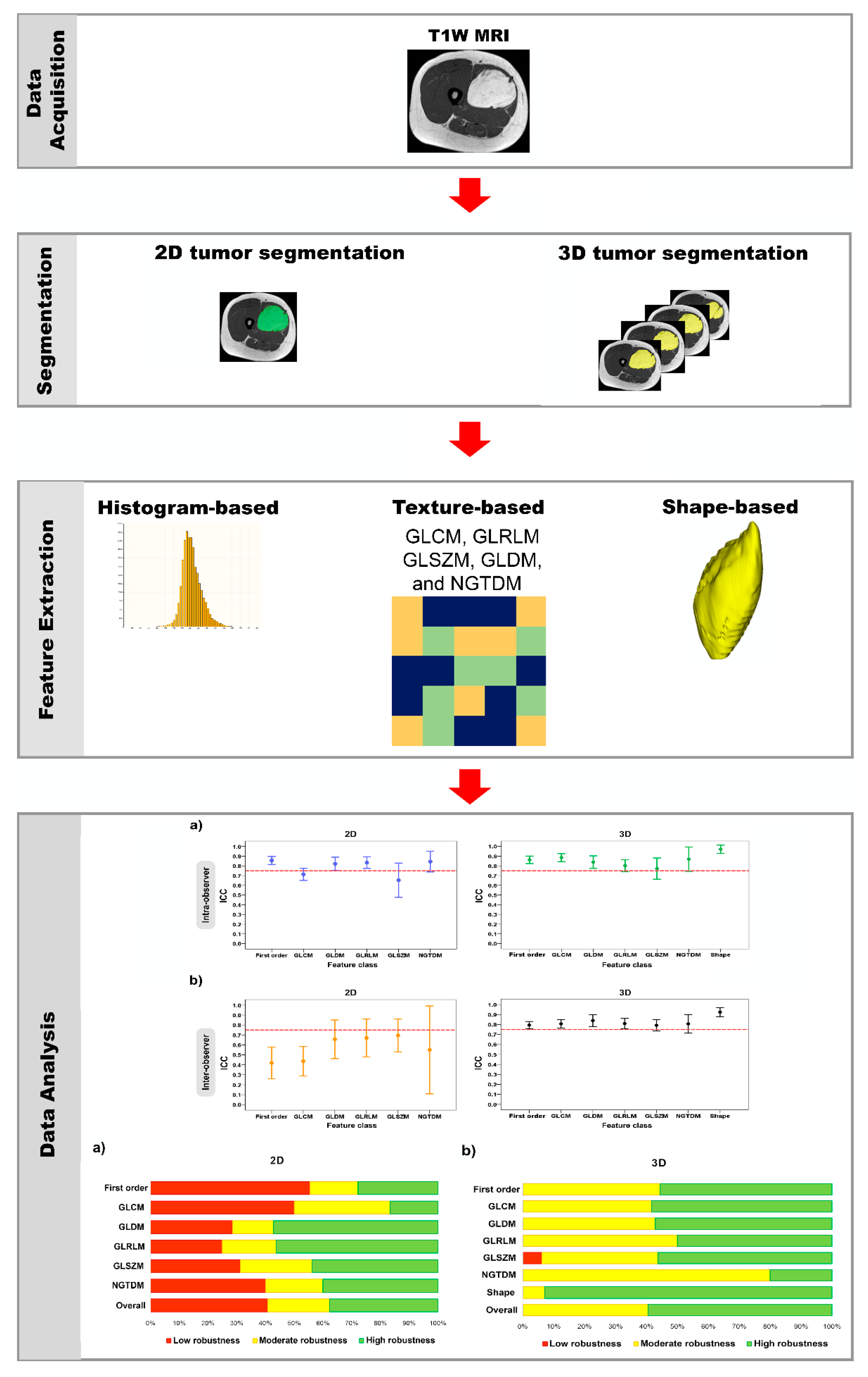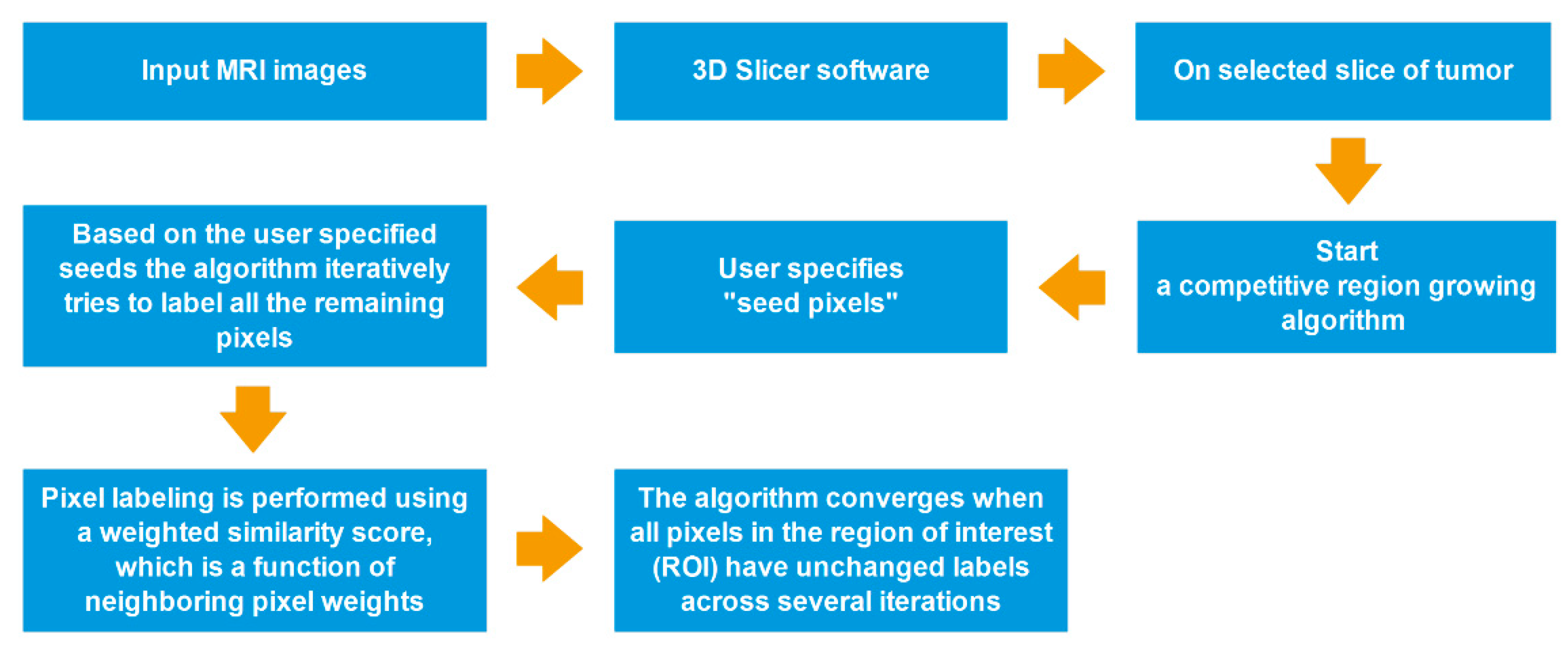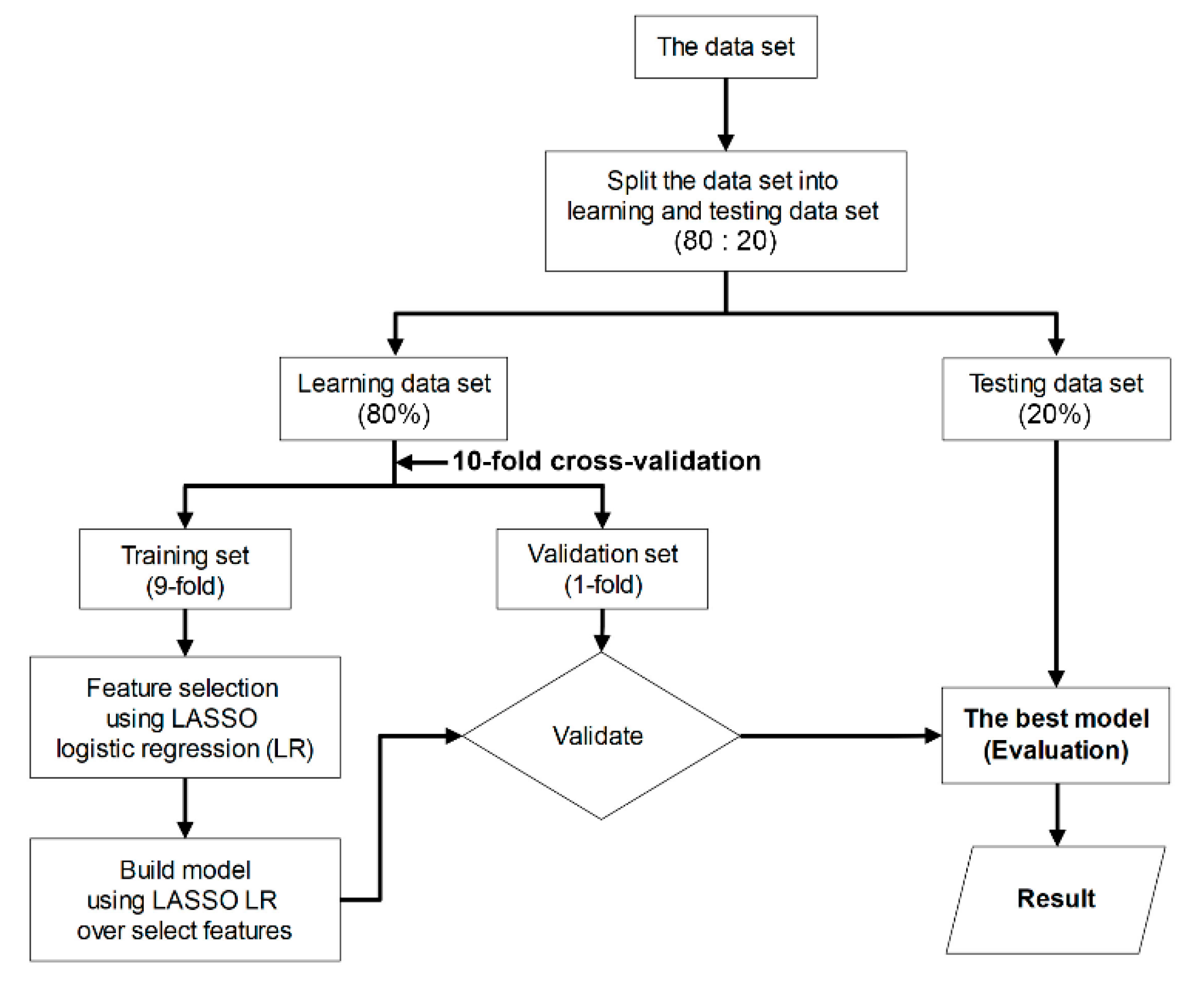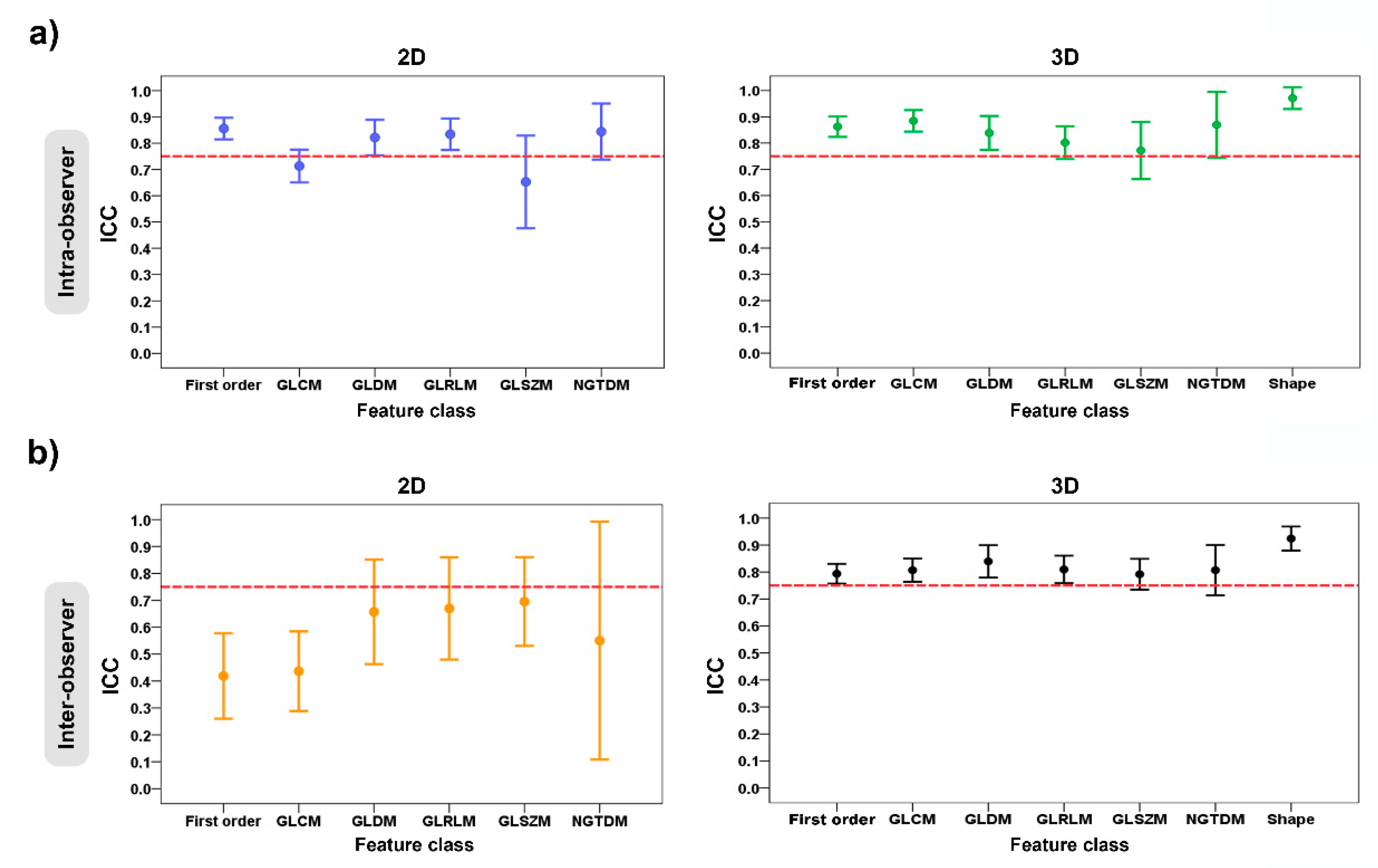Robustness of Radiomic Features: Two-Dimensional versus Three-Dimensional MRI-Based Feature Reproducibility in Lipomatous Soft-Tissue Tumors
Abstract
1. Introduction
2. Materials and Methods
2.1. Patients
2.2. MRI Data Sets
2.3. Two-Dimensional and Three-Dimensional MRI Image Segmentations
2.4. Radiomic Feature Extraction
2.5. Diagnotic Efficacy of MRI-Based Radiomic Features
2.6. Statistical Analysis
3. Results
4. Discussion
5. Conclusions
Author Contributions
Funding
Institutional Review Board Statement
Informed Consent Statement
Data Availability Statement
Acknowledgments
Conflicts of Interest
Appendix A
| Feature | Feature-Class Name | Feature Name | Formula | Definition |
|---|---|---|---|---|
| Histogram-based | First order: When X is set of voxel intensity within a segmented ROI. | firstorder_Skewness | Skewness = | Measures the asymmetry of the distribution of voxel intensity within a segmented ROI.
|
| Texture-based | Gray-level co-occurrence matrix (GLCM): where is the normalized co-occurrence matrix (p(i,j) = P(i,j)/ ). P(i,j) is the co-occurrence matrix for an arbitrary and . Ng is the number of discrete intensity levels in the image. | glcm_Contrast | Contrast = | Measures the local intensity variation, favoring values away from the diagonal (i = j). Larger values suggest that there is a stronger correlation, with a greater disparity in intensity values between neighboring voxels. |
| Gray-level run-length matrix (GLRLM): where Ng is the number of discrete intensity values in the image. Nr is the number of discrete run lengths in the image. P(i,j) is the run-length matrix for an arbitrary direction , when i = 1,2,3,…, Ng and j = 1,2,3,…, Nr. | glrlm_LongRunHighGrayLevelEmphasis (LRHGLE) | LRHGLE = | Reflects graininess.
| |
| Gray-level size-zone matrix (GLSZM): where Ng is the number of discrete intensity values in the image. Ns is the number of discrete zone sizes in the image. Np is the number of voxels in the image. Nz is the number of zones in the ROI, which is equal to and 1 ≤ Nz ≤ Np. P(i,j) is the size-zone matrix, when i = 1,2,3,…, Ng and j = 1,2,3,…, Ns. | glszm_LargeArea HighGrayLevel Emphasis (LAHGLE) | LAHGLE = | Measures the proportion in the image of the joint distribution of larger zones with higher gray-level values.
| |
| Shape-based 3D | Shape | shape_SurfaceVolume Ratio | Surface-area-to-volume ratio = A/V, where A =. The values and are edges of the ith triangle in the mesh, formed by vertices , and . V is shape_MeshVolume feature (i.e., the mesh volume in mm3 of the segmented ROI). where is the number of faces (triangles) defining the mesh. For each face i in the mesh, defined by points , and , the (signed) volume of the tetrahedron defined by that face and the origin of the image (O) is calculated. | Lower values indicates that there is a more compact (sphere-like) shape. |
References
- Johnson, C.N.; Ha, A.S.; Chen, E.; Davidson, D. Lipomatous soft-tissue tumors. J. Am. Acad. Orthop. Surg. 2018, 26, 779–788. [Google Scholar] [CrossRef] [PubMed]
- Zyluk, A. Clinical presentation and outcomes of surgery for upper extremity lipomas. Ortop. Traumatol. Rehabil. 2021, 23, 393–400. [Google Scholar] [CrossRef] [PubMed]
- Su, C.H.; Hung, J.K.; Chang, I.L. Surgical treatment of intramuscular, infiltrating lipoma. Int. Surg. 2011, 96, 56–59. [Google Scholar] [CrossRef]
- Sbaraglia, M.; Dei Tos, A.P.; Pedeutour, F. WHO classification of tumours editorial boards soft tissue and bone tumours. In Atypical Lipomatous Tumor/Well Differentiated Liposarcoma, 5th ed.; IARC Press: Lyon, France, 2020. [Google Scholar]
- Choi, K.Y.; Jost, E.; Mack, L.; Bouchard-Fortier, A. Surgical management of truncal and extremities atypical lipomatous tumors/well-differentiated liposarcoma: A systematic review of the literature. Am. J. Surg. 2020, 219, 823–827. [Google Scholar] [CrossRef]
- Fourman, M.S.; van Eck, C.F.; Weiss, K.R.; Goodman, M.A.; McGough, R.L. Atypical lipomatous tumors: Does our inconsistent terminology have patient repercussions? Results of a Meta-analysis. Am. J. Clin. Oncol. 2019, 42, 487–492. [Google Scholar] [CrossRef] [PubMed]
- Lazarides, A.L.; Ferlauto, H.R.; Burke, Z.D.C.; Griffin, A.M.; Leckey, B.D., Jr.; Bernthal, N.M.; Wunder, J.S.; Ferguson, P.C.; Visgauss, J.D.; Brigman, B.E.; et al. The utility of chest imaging for surveillance of atypical lipomatous tumors. Sarcoma 2021, 2021, 4740924. [Google Scholar] [CrossRef]
- Nagano, S.; Yokouchi, M.; Setoguchi, T.; Ishidou, Y.; Sasaki, H.; Shimada, H.; Komiya, S. Differentiation of lipoma and atypical lipomatous tumor by a scoring system: Implication of increased vascularity on pathogenesis of liposarcoma. BMC Musculoskelet. Disord. 2015, 16, 36. [Google Scholar] [CrossRef]
- Kammerer-Jacquet, S.F.; Thierry, S.; Cabillic, F.; Lannes, M.; Burtin, F.; Henno, S.; Dugay, F.; Bouzille, G.; Rioux-Leclercq, N.; Belaud-Rotureau, M.A.; et al. Differential diagnosis of atypical lipomatous tumor/well-differentiated liposarcoma and dedifferentiated liposarcoma: Utility of p16 in combination with MDM2 and CDK4 immunohistochemistry. Hum. Pathol. 2017, 59, 34–40. [Google Scholar] [CrossRef]
- Ware, P.L.; Snow, A.N.; Gvalani, M.; Pettenati, M.J.; Qasem, S.A. MDM2 copy numbers in well-differentiated and dedifferentiated liposarcoma: Characterizing progression to high-grade tumors. Am. J. Clin. Pathol. 2014, 141, 334–341. [Google Scholar] [CrossRef]
- Thway, K.; Flora, R.; Shah, C.; Olmos, D.; Fisher, C. Diagnostic utility of p16, CDK4, and MDM2 as an immunohistochemical panel in distinguishing well-differentiated and dedifferentiated liposarcomas from other adipocytic tumors. Am. J. Surg. Pathol. 2012, 36, 462–469. [Google Scholar] [CrossRef]
- Coran, A.; Ortolan, P.; Attar, S.; Alberioli, E.; Perissinotto, E.; Tosi, A.L.; Montesco, M.C.; Rossi, C.R.; Tropea, S.; Rastrelli, M.; et al. Magnetic resonance imaging assessment of lipomatous soft-tissue tumors. Vivo 2017, 31, 387–395. [Google Scholar] [CrossRef] [PubMed]
- Brisson, M.; Kashima, T.; Delaney, D.; Tirabosco, R.; Clarke, A.; Cro, S.; Flanagan, A.M.; O’Donnell, P. MRI characteristics of lipoma and atypical lipomatous tumor/well-differentiated liposarcoma: Retrospective comparison with histology and MDM2 gene amplification. Skelet. Radiol. 2013, 42, 635–647. [Google Scholar] [CrossRef]
- O’Donnell, P.W.; Griffin, A.M.; Eward, W.C.; Sternheim, A.; White, L.M.; Wunder, J.S.; Ferguson, P.C. Can experienced observers differentiate between lipoma and well-differentiated liposarcoma using only MRI? Sarcoma 2013, 2013, 982784. [Google Scholar] [CrossRef]
- Malinauskaite, I.; Hofmeister, J.; Burgermeister, S.; Neroladaki, A.; Hamard, M.; Montet, X.; Boudabbous, S. Radiomics and machine learning differentiate soft-tissue lipoma and liposarcoma better than musculoskeletal radiologists. Sarcoma 2020, 2020, 7163453. [Google Scholar] [CrossRef]
- Thavikulwat, A.C.; Wu, J.S.; Chen, X.; Anderson, M.E.; Ward, A.; Kung, J. Image-guided core needle biopsy of adipocytic tumors: Diagnostic accuracy and concordance with final surgical pathology. AJR Am. J. Roentgenol. 2021, 216, 997–1002. [Google Scholar] [CrossRef]
- Leporq, B.; Bouhamama, A.; Pilleul, F.; Lame, F.; Bihane, C.; Sdika, M.; Blay, J.Y.; Beuf, O. MRI-based radiomics to predict lipomatous soft tissue tumors malignancy: A pilot study. Cancer Imaging 2020, 20, 78. [Google Scholar] [CrossRef]
- Pressney, I.; Khoo, M.; Endozo, R.; Ganeshan, B.; O’Donnell, P. Pilot study to differentiate lipoma from atypical lipomatous tumour/well-differentiated liposarcoma using MR radiomics-based texture analysis. Skelet. Radiol. 2020, 49, 1719–1729. [Google Scholar] [CrossRef]
- Thornhill, R.E.; Golfam, M.; Sheikh, A.; Cron, G.O.; White, E.A.; Werier, J.; Schweitzer, M.E.; Di Primio, G. Differentiation of lipoma from liposarcoma on MRI using texture and shape analysis. Acad. Radiol. 2014, 21, 1185–1194. [Google Scholar] [CrossRef]
- Vos, M.; Starmans, M.P.A.; Timbergen, M.J.M.; van der Voort, S.R.; Padmos, G.A.; Kessels, W.; Niessen, W.J.; van Leenders, G.; Grünhagen, D.J.; Sleijfer, S.; et al. Radiomics approach to distinguish between well differentiated liposarcomas and lipomas on MRI. Br. J. Surg. 2019, 106, 1800–1809. [Google Scholar] [CrossRef]
- Yang, Y.; Zhou, Y.; Zhou, C.; Ma, X. Novel computer aided diagnostic models on multimodality medical images to differentiate well differentiated liposarcomas from lipomas approached by deep learning methods. Orphanet J. Rare Dis. 2022, 17, 158. [Google Scholar] [CrossRef]
- Tang, Y.; Cui, J.; Zhu, J.; Fan, G. Differentiation between lipomas and atypical lipomatous tumors of the extremities using radiomics. J. Magn. Reson. Imaging 2022, 56, 1746–1754. [Google Scholar] [CrossRef]
- Cay, N.; Mendi, B.A.R.; Batur, H.; Erdogan, F. Discrimination of lipoma from atypical lipomatous tumor/well-differentiated liposarcoma using magnetic resonance imaging radiomics combined with machine learning. Jpn. J. Radiol. 2022, 40, 951–960. [Google Scholar] [CrossRef]
- Dong, X.; Li, H.; Jiang, Z.; Grunleitner, T.; Guler, I.; Dong, J.; Wang, K.; Kohler, M.H.; Jakobi, M.; Menze, B.H.; et al. 3D deep learning enables accurate layer mapping of 2D materials. ACS Nano 2021, 15, 3139–3151. [Google Scholar] [CrossRef]
- Binh, M.B.; Sastre-Garau, X.; Guillou, L.; de Pinieux, G.; Terrier, P.; Lagace, R.; Aurias, A.; Hostein, I.; Coindre, J.M. MDM2 and CDK4 immunostainings are useful adjuncts in diagnosing well-differentiated and dedifferentiated liposarcoma subtypes: A comparative analysis of 559 soft tissue neoplasms with genetic data. Am. J. Surg. Pathol. 2005, 29, 1340–1347. [Google Scholar] [CrossRef]
- Fedorov, A.; Beichel, R.; Kalpathy-Cramer, J.; Finet, J.; Fillion-Robin, J.C.; Pujol, S.; Bauer, C.; Jennings, D.; Fennessy, F.; Sonka, M.; et al. 3D Slicer as an image computing platform for the quantitative imaging network. Magn. Reson Imaging 2012, 30, 1323–1341. [Google Scholar] [CrossRef] [PubMed]
- Kikinis, R.; Pieper, S. 3D Slicer as a tool for interactive brain tumor segmentation. Annu. Int. Conf. IEEE Eng. Med. Biol. Soc. 2011, 2011, 6982–6984. [Google Scholar]
- Slicer, D. Slicer-Community 3D Slicer Documentation; 3D Slicer: Boston, MA, USA, 2019. [Google Scholar]
- Parmar, C.; Rios Velazquez, E.; Leijenaar, R.; Jermoumi, M.; Carvalho, S.; Mak, R.H.; Mitra, S.; Shankar, B.U.; Kikinis, R.; Haibe-Kains, B.; et al. Robust Radiomics feature quantification using semiautomatic volumetric segmentation. PLoS ONE 2014, 9, e102107. [Google Scholar] [CrossRef]
- Sun, X.; Shi, L.; Luo, Y.; Yang, W.; Li, H.; Liang, P.; Li, K.; Mok, V.C.T.; Chu, W.C.W.; Wang, D. Histogram-based normalization technique on human brain magnetic resonance images from different acquisitions. BioMedical Eng. OnLine 2015, 14, 73. [Google Scholar] [CrossRef] [PubMed]
- van Griethuysen, J.J.M.; Fedorov, A.; Parmar, C.; Hosny, A.; Aucoin, N.; Narayan, V.; Beets-Tan, R.G.H.; Fillion-Robin, J.C.; Pieper, S.; Aerts, H. Computational radiomics system to decode the radiographic phenotype. Cancer Res. 2017, 77, e104–e107. [Google Scholar] [CrossRef] [PubMed]
- Haralick, R.M.; Shanmugam, K.; Dinstein, I. Textural features for image classification. IEEE Trans. Syst. Man Cybern. 1973, 6, 610–621. [Google Scholar] [CrossRef]
- Galloway, M.M. Texture analysis using gray level run lengths. Comput. Graph. Image Process. 1975, 4, 172–179. [Google Scholar] [CrossRef]
- Mayerhoefer, M.E.; Materka, A.; Langs, G.; Häggström, I.; Szczypiński, P.; Gibbs, P.; Cook, G. Introduction to radiomics. J. Nucl. Med. 2020, 61, 488–495. [Google Scholar] [CrossRef]
- Parekh, V.; Jacobs, M.A. Radiomics: A new application from established techniques. Expert Rev. Precis. Med. Drug. Dev. 2016, 1, 207–226. [Google Scholar] [CrossRef]
- Scapicchio, C.; Gabelloni, M.; Barucci, A.; Cioni, D.; Saba, L.; Neri, E. A deep look into radiomics. La Radiol. Med. 2021, 126, 1296–1311. [Google Scholar] [CrossRef] [PubMed]
- Tibshirani, R. Regression shrinkage and selection via the Lasso. J. R. Stat. Society. Ser. B (Methodol.) 1996, 58, 267–288. [Google Scholar] [CrossRef]
- Dinov, I.D. Data Science and Predictive Analytics; Springer: Cham, Switzerland, 2018. [Google Scholar]
- Pisner, D.A.; Schnyer, D.M. Chapter 6—Support vector machine. In Machine Learning; Mechelli, A., Vieira, S., Eds.; Academic Press: Cambridge, MA, USA, 2020; pp. 101–121. [Google Scholar]
- Shan, G. Monte Carlo cross-validation for a study with binary outcome and limited sample size. BMC Med. Inform. Decis. Mak. 2022, 22, 270. [Google Scholar] [CrossRef]
- Traverso, A.; Kazmierski, M.; Welch, M.L.; Weiss, J.; Fiset, S.; Foltz, W.D.; Gladwish, A.; Dekker, A.; Jaffray, D.; Wee, L.; et al. Sensitivity of radiomic features to inter-observer variability and image pre-processing in Apparent Diffusion Coefficient (ADC) maps of cervix cancer patients. Radiother. Oncol. 2020, 143, 88–94. [Google Scholar] [CrossRef]
- Koo, T.K.; Li, M.Y. A guideline of selecting and reporting intraclass correlation coefficients for reliability research. J. Chiropr. Med. 2016, 15, 155–163. [Google Scholar] [CrossRef] [PubMed]
- Schmidt, B.; Dick, A.; Treutlein, M.; Schiller, P.; Bunck, A.C.; Maintz, D.; Baeßler, B. Intra- and inter-observer reproducibility of global and regional magnetic resonance feature tracking derived strain parameters of the left and right ventricle. Eur. J. Radiol. 2017, 89, 97–105. [Google Scholar] [CrossRef]
- Luo, Z.; Li, J.; Liao, Y.; Liu, R.; Shen, X.; Chen, W. Radiomics analysis of multiparametric MRI for prediction of synchronous lung metastases in osteosarcoma. Front. Oncol. 2022, 12, 802234. [Google Scholar] [CrossRef]
- Kocak, B.; Durmaz, E.; Kaya, O.; Ates Kus, E.; Kilickesmez, O. Reliability of single-slice–based 2D CT texture analysis of renal masses: Influence of intra- and interobserver manual segmentation variability on radiomic feature reproducibility. Am. J. Roentgenol. 2019, 213, 377–383. [Google Scholar] [CrossRef] [PubMed]
- Rizzetto, F.; Calderoni, F.; De Mattia, C.; Defeudis, A.; Giannini, V.; Mazzetti, S.; Vassallo, L.; Ghezzi, S.; Sartore-Bianchi, A.; Marsoni, S.; et al. Impact of inter-reader contouring variability on textural radiomics of colorectal liver metastases. Eur. Radiol. Exp. 2020, 4, 62. [Google Scholar] [CrossRef]
- Zwanenburg, A.; Leger, S.; Agolli, L.; Pilz, K.; Troost, E.G.C.; Richter, C.; Löck, S. Assessing robustness of radiomic features by image perturbation. Sci. Rep. 2019, 9, 614. [Google Scholar] [CrossRef]
- Cattell, R.; Chen, S.; Huang, C. Robustness of radiomic features in magnetic resonance imaging: Review and a phantom study. Vis. Comput. Ind. Biomed. Art 2019, 2, 19. [Google Scholar] [PubMed]
- Fradet, G.; Ayde, R.; Bottois, H.; El Harchaoui, M.; Khaled, W.; Drapé, J.L.; Pilleul, F.; Bouhamama, A.; Beuf, O.; Leporq, B. Prediction of lipomatous soft tissue malignancy on MRI: Comparison between machine learning applied to radiomics and deep learning. Eur. Radiol. Exp. 2022, 6, 41. [Google Scholar] [CrossRef] [PubMed]
- Gitto, S.; Cuocolo, R.; Emili, I.; Tofanelli, L.; Chianca, V.; Albano, D.; Messina, C.; Imbriaco, M.; Sconfienza, L.M. Effects of interobserver variability on 2D and 3D CT- and MRI-based texture feature reproducibility of cartilaginous bone tumors. J. Digit. Imaging 2021, 34, 820–832. [Google Scholar] [CrossRef]






| Variable | Total Patients (n = 60) | IM Lipoma (n = 40) | ALTs/WDLSs (n = 20) | p Value |
|---|---|---|---|---|
| Gender | ||||
| male | 21 (35.0%) | 12 (30.0%) | 9 (45.0%) | 0.3 |
| female | 39 (65.0%) | 28 (70.0%) | 11 (55.0%) | |
| Age (year) | 60.2 (9.5) | 60.6 (9.1) | 59.7 (10.3) | 0.7 |
| Location of tumor | ||||
| Thigh | 29 | 15 | 14 | |
| Arm | 14 | 12 | 2 | |
| Shoulder | 10 | 10 | 0 | |
| Leg | 5 | 1 | 4 | |
| Back/trunk | 2 | 2 | 0 |
| Feature Class | 2D Tumor Segmentation | 3D Tumor Segmentation | ||||
|---|---|---|---|---|---|---|
| Number of Total Features | ICC Value | Stable Feature Rate (%) | Number of Total Features | ICC Value | Stable Feature Rate (%) | |
| First order | 18 | 0.86 ± 0.09 | 77.8 | 18 | 0.86 ± 0.08 | 83.3 |
| GLCM | 24 | 0.71 ± 0.15 | 37.5 | 24 | 0.88 ± 0.10 | 83.3 |
| GLRLM | 16 | 0.83 ± 0.12 | 81.3 | 16 | 0.80 ± 0.12 | 68.8 |
| GLSZM | 16 | 0.65 ± 0.35 | 56.3 | 16 | 0.77 ± 0.22 | 68.8 |
| GLDM | 14 | 0.82 ± 0.13 | 71.4 | 14 | 0.84 ± 0.12 | 78.6 |
| NGTDM | 5 | 0.84 ± 0.12 | 80.0 | 5 | 0.87 ± 0.14 | 60.0 |
| Shape | - | - | - | 14 | 0.97 ± 0.08 | 92.9 |
| Overall | 93 | 0.77 ± 0.20 | 63.4 | 107 | 0.86 ± 0.14 | 78.5 |
| Feature Class | 2D Tumor Segmentation | 3D Tumor Segmentation | ||||
|---|---|---|---|---|---|---|
| Number of Total Features | ICC Value | Stable Feature Rate (%) | Number of Total Features | ICC Value | Stable Feature Rate (%) | |
| First order | 18 | 0.42 ± 0.34 | 27.8 | 18 | 0.79 ± 0.09 | 72.2 |
| GLCM | 24 | 0.44 ± 0.36 | 25.0 | 24 | 0.81 ± 0.11 | 70.8 |
| GLRLM | 16 | 0.67 ± 0.38 | 62.5 | 16 | 0.81 ± 0.10 | 68.8 |
| GLSZM | 16 | 0.70 ± 0.33 | 62.5 | 16 | 0.79 ± 0.11 | 62.5 |
| GLDM | 14 | 0.66 ± 0.36 | 64.3 | 14 | 0.84 ± 0.11 | 64.3 |
| NGTDM | 5 | 0.55 ± 0.49 | 60.0 | 5 | 0.81 ± 0.10 | 60.0 |
| Shape | - | - | - | 14 | 0.92 ± 0.08 | 92.9 |
| Overall | 93 | 0.56 ± 0.37 | 46.2 | 107 | 0.82 ± 0.11 | 71.0 |
| Feature Class | 2D Tumor Segmentation | 3D Tumor Segmentation | ||||||
|---|---|---|---|---|---|---|---|---|
| Total Features | Low Robustness | Moderate Robustness | High Robustness | Total Features | Low Robustness | Moderate Robustness | High Robustness | |
| First order | 18 | 10 | 3 | 5 | 18 | 0 | 8 | 10 |
| GLCM | 24 | 12 | 8 | 4 | 24 | 0 | 10 | 14 |
| GLRLM | 16 | 4 | 3 | 9 | 16 | 0 | 8 | 8 |
| GLSZM | 16 | 5 | 4 | 7 | 16 | 1 | 6 | 9 |
| GLDM | 14 | 4 | 2 | 8 | 14 | 0 | 6 | 8 |
| NGTDM | 5 | 2 | 1 | 2 | 5 | 0 | 4 | 1 |
| Shape | - | - | - | - | 14 | 0 | 1 | 13 |
| Overall | 93 | 38 | 20 | 35 | 107 | 1 | 43 | 63 |
| Stable feature rate | - | - | - | 37.6% (35/93) | - | - | - | 58.9% (63/107) |
| Machine Learning | Features | Number of Reproducible Features | Number of Selected Features in Final Model | Sensitivity (%) | Specificity (%) | Accuracy (%) |
|---|---|---|---|---|---|---|
| Model 1 | 2D radiomic features only | 35 | 13 | 75 | 100 | 88 |
| Model 2 | 3D radiomic features only | 63 | 10 | 83 | 100 | 90 |
| Model 3 | 2D + 3D radiomic features | 98 | 4 | 100 | 80 | 87 |
| Study | Segmentation Technique | Stable Feature Rate | Strengths | Weaknesses |
|---|---|---|---|---|
| Cay, 2022 [23] |
| 87.8% |
|
|
| Fradet, 2022 [49] |
| N/A |
|
|
| Yang, 2022 [21] |
| N/A |
|
|
| Tang, 2022 [22] |
| T1W, 42.3%; FS T2W 25.0%; and T1W & T2W, 39.4% |
|
|
| Pressney, 2020 [18] |
| N/A |
|
|
| Leporq, 2020 [17] |
| 63.2% |
|
|
| Malinauskaite, 2020 [15] |
| 76.1% |
|
|
| Vos, 2019 [20] |
| N/A |
|
|
| Thornhill, 2014 [19] |
| N/A |
|
|
| Current study |
| 37.6% |
|
|
| 58.9% |
Disclaimer/Publisher’s Note: The statements, opinions and data contained in all publications are solely those of the individual author(s) and contributor(s) and not of MDPI and/or the editor(s). MDPI and/or the editor(s) disclaim responsibility for any injury to people or property resulting from any ideas, methods, instructions or products referred to in the content. |
© 2023 by the authors. Licensee MDPI, Basel, Switzerland. This article is an open access article distributed under the terms and conditions of the Creative Commons Attribution (CC BY) license (https://creativecommons.org/licenses/by/4.0/).
Share and Cite
Sudjai, N.; Siriwanarangsun, P.; Lektrakul, N.; Saiviroonporn, P.; Maungsomboon, S.; Phimolsarnti, R.; Asavamongkolkul, A.; Chandhanayingyong, C. Robustness of Radiomic Features: Two-Dimensional versus Three-Dimensional MRI-Based Feature Reproducibility in Lipomatous Soft-Tissue Tumors. Diagnostics 2023, 13, 258. https://doi.org/10.3390/diagnostics13020258
Sudjai N, Siriwanarangsun P, Lektrakul N, Saiviroonporn P, Maungsomboon S, Phimolsarnti R, Asavamongkolkul A, Chandhanayingyong C. Robustness of Radiomic Features: Two-Dimensional versus Three-Dimensional MRI-Based Feature Reproducibility in Lipomatous Soft-Tissue Tumors. Diagnostics. 2023; 13(2):258. https://doi.org/10.3390/diagnostics13020258
Chicago/Turabian StyleSudjai, Narumol, Palanan Siriwanarangsun, Nittaya Lektrakul, Pairash Saiviroonporn, Sorranart Maungsomboon, Rapin Phimolsarnti, Apichat Asavamongkolkul, and Chandhanarat Chandhanayingyong. 2023. "Robustness of Radiomic Features: Two-Dimensional versus Three-Dimensional MRI-Based Feature Reproducibility in Lipomatous Soft-Tissue Tumors" Diagnostics 13, no. 2: 258. https://doi.org/10.3390/diagnostics13020258
APA StyleSudjai, N., Siriwanarangsun, P., Lektrakul, N., Saiviroonporn, P., Maungsomboon, S., Phimolsarnti, R., Asavamongkolkul, A., & Chandhanayingyong, C. (2023). Robustness of Radiomic Features: Two-Dimensional versus Three-Dimensional MRI-Based Feature Reproducibility in Lipomatous Soft-Tissue Tumors. Diagnostics, 13(2), 258. https://doi.org/10.3390/diagnostics13020258





